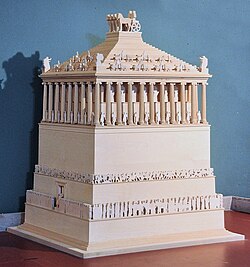| Mausoleum at Halicarnassus | |
|---|---|
 Model of the Mausoleum at Halicarnassus, at the Bodrum Museum of Underwater Archaeology. | |
| General information | |
| Status | Destroyed by earthquakes |
| Type | Mausoleum |
| Architectural style | Classical |
| Town or city | Halicarnassus, Achaemenid Empire (modern-day Bodrum, Turkey) |
| Country | Achaemenid Empire; modern day Turkey; |
| Coordinates | 37°02′16″N 27°25′27″E / 37.0379°N 27.4241°E |
| Opened | 351 BC |
| Demolished | 1494 AD |
| Client | Mausolus and Artemisia II of Caria |
| Owner | Artaxerxes III |
| Height | Approximately 45 m (148 ft) |
| Design and construction | |
| Architect(s) | Satyros and Pythius of Priene |
| Other designers | Leochares, Bryaxis, Scopas and Timotheus |
The Mausoleum at Halicarnassus or Tomb of Mausolus[a] (Ancient Greek: Μαυσωλεῖον τῆς Ἁλικαρνασσοῦ; Turkish: Halikarnas Mozolesi) was a tomb built between 353 and 351 BC in Halicarnassus (present Bodrum, Turkey) for Mausolus, an Anatolian from Caria and a satrap in the Achaemenid Persian Empire, and his sister-wife Artemisia II of Caria. The structure was designed by the Greek architects Satyros and Pythius of Priene.[1][2] Its elevated tomb structure is derived from the tombs of neighbouring Lycia, a territory Mausolus had invaded and annexed c. 360 BC, such as the Nereid Monument.[3]
The Mausoleum was approximately 45 m (148 ft) in height, and the four sides were adorned with sculptural reliefs, each created by one of four Greek sculptors: Leochares, Bryaxis, Scopas of Paros, and Timotheus.[4] The Mausoleum contained 400 freestanding sculptures.[5] The mausoleum was considered to be such an aesthetic triumph that Antipater of Sidon identified it as one of his Seven Wonders of the Ancient World. It was destroyed by successive earthquakes from the 12th to the 15th century;[6][7][8] it was the last surviving of the six destroyed wonders.
The word mausoleum has now come to be used generically for an above-ground tomb.
Cite error: There are <ref group=lower-alpha> tags or {{efn}} templates on this page, but the references will not show without a {{reflist|group=lower-alpha}} template or {{notelist}} template (see the help page).
- ^ Kostof, Spiro (1985). A History of Architecture. Oxford: Oxford University Press. p. 9. ISBN 0-19-503473-2.
- ^ Gloag, John (1969) [1958]. Guide to Western Architecture (Revised ed.). The Hamlyn Publishing Group. p. 362.
- ^ André-Salvini, Béatrice (2005). Forgotten Empire: The World of Ancient Persia. University of California Press. p. 46. ISBN 978-0520247314.
- ^ Smith, William (1870). "Dictionary of Greek and Roman Antiquities". p. 744. Archived from the original on 18 June 2006. Retrieved 21 September 2006.
- ^ "National Geographic – How this massive tomb became a wonder of the ancient world". Zegister. 2 January 2023. Retrieved 3 January 2023.
- ^ "Mausoleum of Halicarnassus". ancienthistory.about.com. Archived from the original on 21 February 2014. Retrieved 5 February 2014.
- ^ "The Mausoleum at Halicarnassus". unmuseum.org. Retrieved 5 February 2014.
- ^ "The Mausoleum of Halicarnassus". bodrumpages.com. Retrieved 5 February 2014.

